Argyreia nervosa
Argyreia nervosa is a perennial climbing vine native to the Indian subcontinent and introduced to numerous areas worldwide, including Hawaii, Africa, and the Caribbean. Though it can be invasive, it is often prized for its aesthetic and medicinal value.[3] Common names include Hawaiian baby woodrose, adhoguda अधोगुडा or vidhara विधारा (Sanskrit), elephant creeper and woolly morning glory. Its seeds are known for their powerful entheogenic value, greater or similar to those of varieties from the Convolvulaceae family, with users reporting significant psychedelic and spiritual experiences.[4][5] The two botanical varieties are A. n. var. nervosa described here, and A. n. var. speciosa, which are used in Ayurvedic medicine for their medicinal value.[3]
| Argyreia nervosa | |
|---|---|
_-_20100808.jpg) | |
| Argyreia nervosa flowers (enlarge) | |
| Scientific classification | |
| Kingdom: | Plantae |
| Clade: | Tracheophytes |
| Clade: | Angiosperms |
| Clade: | Eudicots |
| Clade: | Asterids |
| Order: | Solanales |
| Family: | Convolvulaceae |
| Genus: | Argyreia |
| Species: | A. nervosa |
| Binomial name | |
| Argyreia nervosa (Burm.f.) Bojer | |
| Synonyms[1] | |
|
Argyreia speciosa (L.f.) Sweet | |
Argyreia nervosa seeds contain various ergoline alkaloids such as ergine.[6] A study reported stereoisomers of ergine to be found in the seeds at a concentration of 0.325% of dry weight.[7] A more recent study reported presence of ergometrine, lysergol, lysergic acid and other alkaloids that contribute to its pharmacological effects.[5]
History
While several other plants in the family Convolvulaceae, such as Rivea corymbosa (ololiuhqui) and Ipomoea tricolor (tlitliltzin), were used in shamanic rituals of Latin America for centuries, A. nervosa was not traditionally used for this purpose. Its properties were first brought to attention in the 1960s.
Cultivation
Where temperatures fall below 13oC (55oF), Argyreia nervosa is grown in a warm greenhouse. Elsewhere, it is grown on arbours, pergolas, walls, or trees. It is often grown professionally under glass in a loam-based potting compost (John Innes No. 3) in full light, and watered freely from spring to autumn, with a balanced liquid fertilizer applied monthly and reduced water in winter. It is grown outdoors in moderately fertile, moist but well-drained soil in full sun. Pruning is done in late winter.[8]
Glycosides
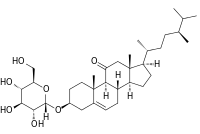
- Argyroside, (24R)-ergost-5-en-11-oxo-3β-ol-α-D-glucopyranoside, a steroidal glycoside unique to Argyreia nervosa[9]
Ergolines
| Ergoline alkaloids of known percentage | ||
|---|---|---|
| Compound name | Percentage of dry seed weight constituted | Chemical structure |
| Isoergine | 0.188% | 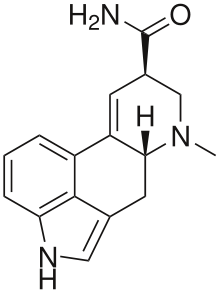 |
| Ergine | 0.136% | |
| Ergometrine | 0.049% | 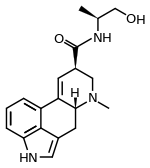 |
| Lysergic acid hydroxyethylamide | 0.035% | 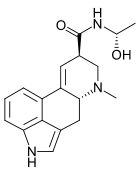 |
| Isolysergic acid hydroxyethylamide | 0.024% | |
| Elymoclavine | 0.022% | 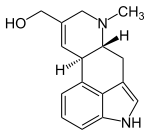 |
| Ergometrinine | 0.011% | 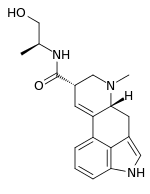 |
| Chanoclavine | 0.016% | 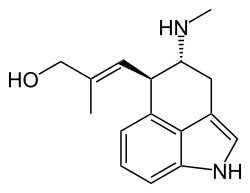 |
| Ergoline alkaloids of unknown percentage | ||
|---|---|---|
| Compound name | Chemical structure | |
| Agroclavine | 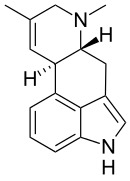 | |
| Festuclavine | 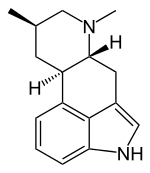 | |
| Chanoclavine II |  | |
| Lysergene | 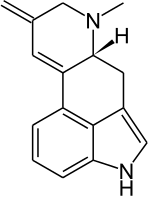 | |
| Lysergol | 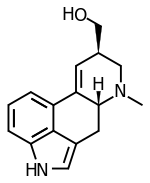 | |
| Isolysergol | ||
| Setoclavine | 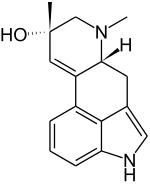 | |
| Isosetoclavine | ||
Hydroxycinnamic acids
| Hydroxycinnamic acids | ||
|---|---|---|
| Compound name | Chemical structure | |
| Caffeic acid |  | |
| Ethyl caffeate |  | |
Fatty acids
| Fatty acids | ||
|---|---|---|
| Compound name | Chemical structure | |
| Myristoleic acid |  | |
| Myristic acid | ||
| Palmitic acid | ||
| Linoleic acid | ||
| Linolenic acid | ||
| Oleic acid |  | |
| Stearic acid | ||
| Nonadecylic acid | ||
| Eicosenoic acid | ||
| Heneicosylic acid | ||
| Behenic acid | ||
| 12-methylmyristic acid | ||
| 15-methylstearic acid | ||
| Glycosides of fatty acids | |
|---|---|
| Fatty acid | Chemical structure |
| Palmitic acid | |
| Oleic acid |  |
| Stearic acid | |
| Behenic acid | |
| Linoleic acid | |
| Linolenic acid | |
Entheogen
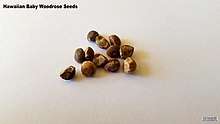
Huna shamans used them according to various oral histories.[10] The seeds of Argyreia nervosa produce psychoactive effects. They contain ergot alkaloids varying considerably in concentration with LSA weight ranging between exactly similar looking seeds from 3 μg to 34 μg (avg 17 μg).[11] However, in its effects, LSA is about one tenth as potent as its cousin LSD, making a threshold dose level for LSA about 500 μg.[12] The psychoactive effects of the seeds may therefore be due to other alkaloids present in them and the safe and effective dose may be difficult to predict.
References
- "Argyreia nervosa". Germplasm Resources Information Network (GRIN). Agricultural Research Service (ARS), United States Department of Agriculture (USDA). Retrieved 2010-11-10.
- Glossary Of Indian Medicinal Plants
- "Medicinal uses and biological activities of Argyreia speciosa Sweet (Hawaiian Baby Woodrose) — An Overview". Indian Journal of Natural Products and Resources: 286–291. September 2011.
- E. Al-Assmar, Sami (1999). "The Seeds of the Hawaiian Baby Woodrose Are a Powerful Hallucinogen". Arch Intern Med. 159 (17): 2090. doi:10.1001/archinte.159.17.2090. PMID 10510998.
- Paulke, Alexander; et al. (2015). "Studies on the alkaloid composition of the Hawaiian Baby Woodrose Argyreia nervosa, a common legal high". Forensic Science International. 249: 281–293. doi:10.1016/j.forsciint.2015.02.011. PMID 25747328.
- Halpern, J.H. (2004). "Hallucinogens and dissociative agents naturally growing in the United States". Pharmacology & Therapeutics. 102 (2): 131–138. doi:10.1016/j.pharmthera.2004.03.003. PMID 15163594.
Although LSD does not occur in nature, a close analogue, lysergic acid amide (LSA, ‘‘ergine’’) is found in the seeds of Argyreia nervosa (Hawaiian baby woodrose)
- Chao JM, Der Marderosian AH (1973). "Ergoline alkaloidal constituents of Hawaiian baby wood rose, Argyreia nervosa (Burmf) Bojer". J. Pharm. Sci. 62 (4): 588–91. doi:10.1002/jps.2600620409. PMID 4698977.
- Brickell, Christopher (2016). Royal Horticultural Society: A-Z Encyclopedia Of Garden Plants. Great Britain: Dorling Kindersley. p. 110. ISBN 9780241239124.
- Rahman, A.; Ali, M.; Khan, N. Z. (2003). "Argyroside from Argyreia nervosa Seeds". ChemInform. 34 (21): 60–2. doi:10.1002/chin.200321168. ISSN 0931-7597. PMID 12622256.
- "Entheology.org - Preserving Ancient Knowledge". www.entheology.org.
- Paulke, Alexander; Kremer, Christian; Wunder, Cora; Wurglics, Mario; Schubert-Zsilavecz, Manfred; Toennes, Stefan W. (2014). "Identification of legal highs--ergot alkaloid patterns in two Argyreia nervosa products". Forensic Science International. 242: 62–71. doi:10.1016/j.forsciint.2014.06.025. ISSN 1872-6283. PMID 25036782.
- Wasson, R. Gordon; Hofmann, Albert; Ruck, Carl A. P. (2008). The Road to Eleusis: Unveiling the Secret of the Mysteries. North Atlantic Books. ISBN 9781556437526.
External links
| Wikimedia Commons has media related to Argyreia nervosa. |
| Wikispecies has information related to Argyreia nervosa |
- PLANTS database entry
- Dressler, S.; Schmidt, M. & Zizka, G. (2014). "Argyreia nervosa". African plants – a Photo Guide. Frankfurt/Main: Forschungsinstitut Senckenberg.